Communication and the Healthcare Sector: Challenges and Solutions
VerifiedAdded on 2021/05/31
|7
|1859
|74
Report
AI Summary
This report examines the critical role of communication within the healthcare sector, highlighting its influence on patient care and organizational effectiveness. It emphasizes the importance of effective communication skills for healthcare professionals, including doctors and nurses, and its impact on patient understanding and treatment adherence. The report delves into the cultural factors and values that shape communication styles and the need to consider diverse patient backgrounds. It also discusses the relevance of various legislations, codes of practice, and organizational systems, such as information sharing and patient confidentiality, in fostering effective communication. Furthermore, the report explores methods to enhance communication, such as minimizing technical jargon, utilizing non-verbal cues, and considering patient-specific cultural contexts. Overall, the report underscores the significance of communication as a cornerstone of quality healthcare and provides insights into addressing challenges and improving practices within the healthcare sector.
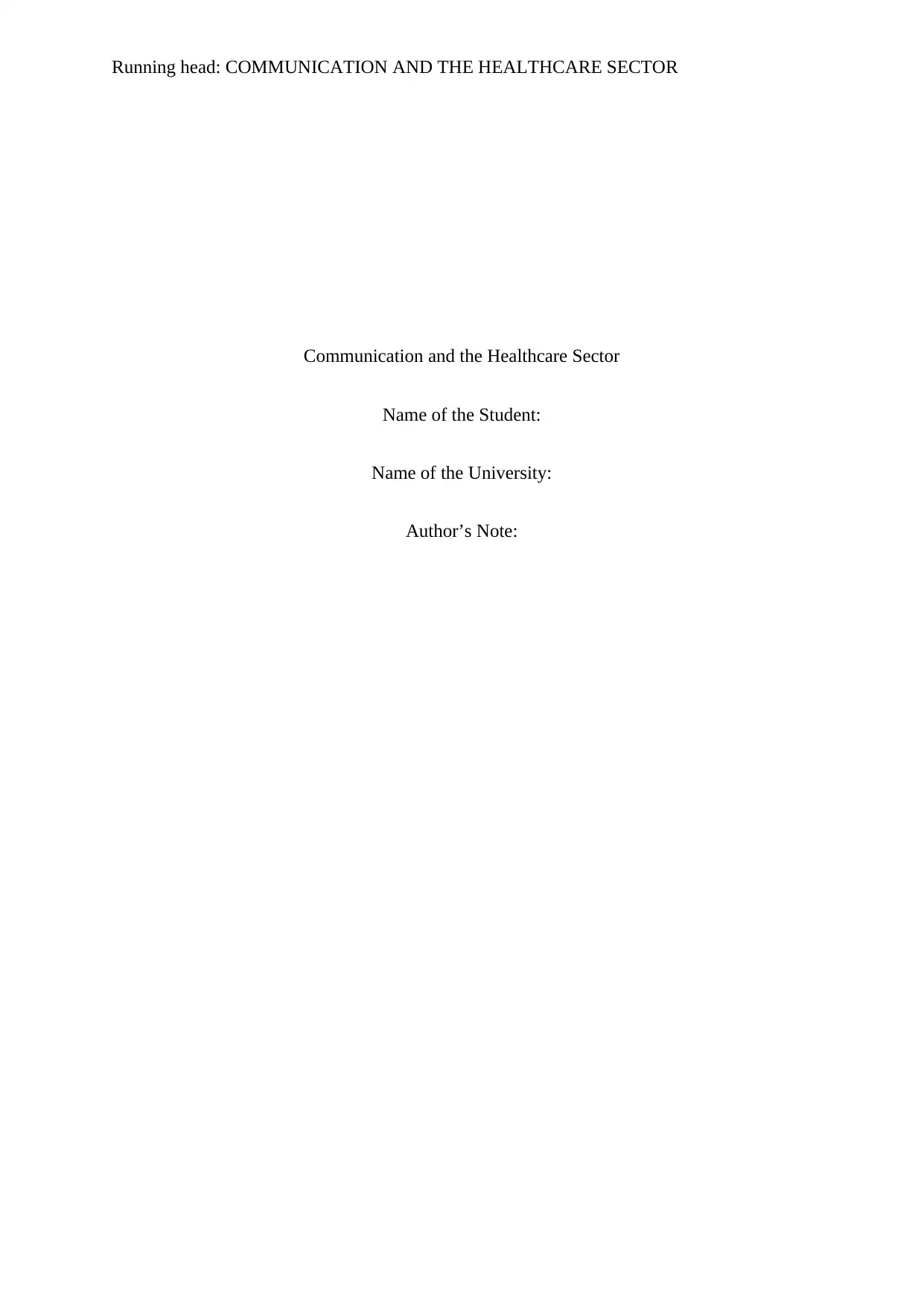
Running head: COMMUNICATION AND THE HEALTHCARE SECTOR
Communication and the Healthcare Sector
Name of the Student:
Name of the University:
Author’s Note:
Communication and the Healthcare Sector
Name of the Student:
Name of the University:
Author’s Note:
Paraphrase This Document
Need a fresh take? Get an instant paraphrase of this document with our AI Paraphraser
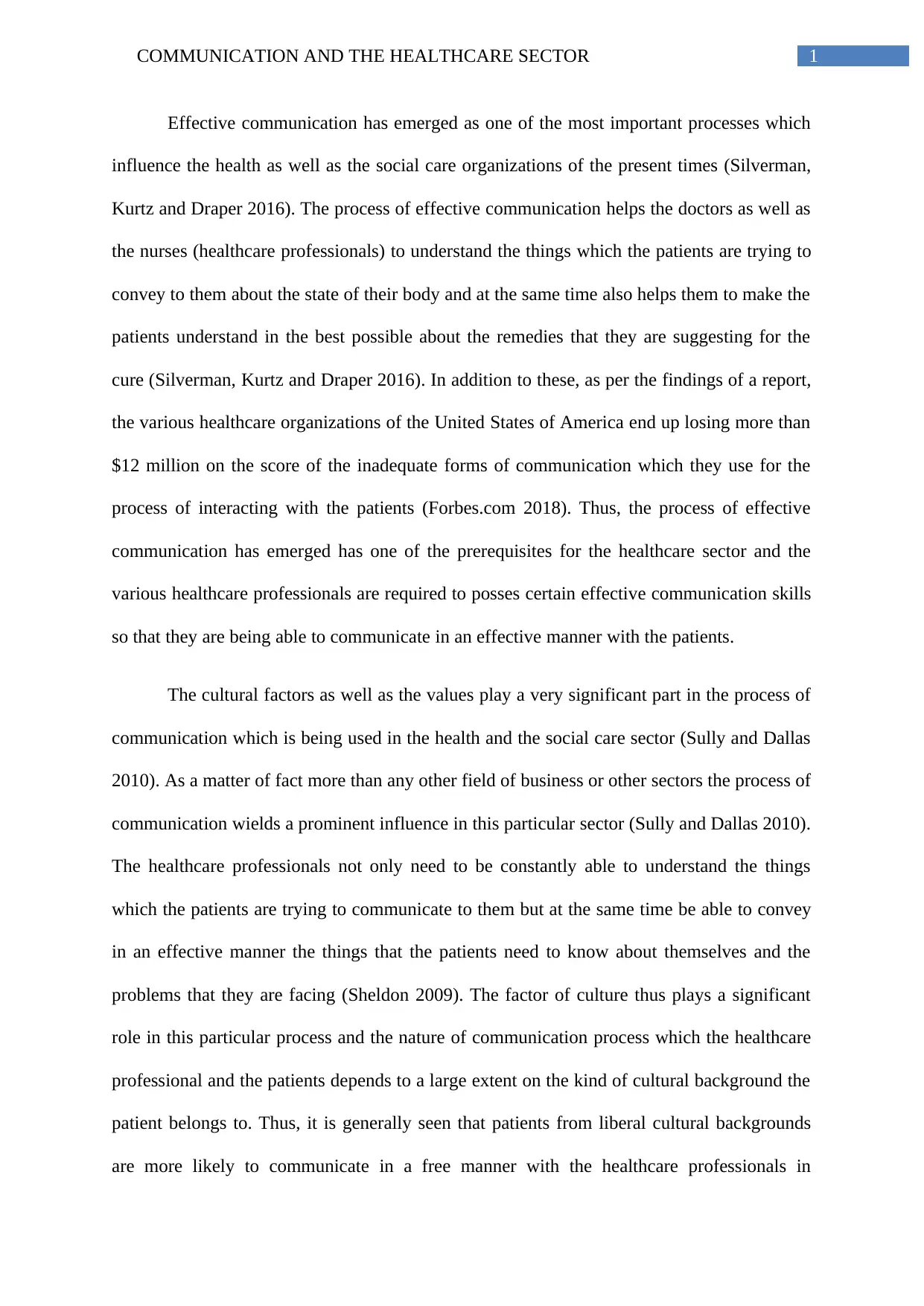
1COMMUNICATION AND THE HEALTHCARE SECTOR
Effective communication has emerged as one of the most important processes which
influence the health as well as the social care organizations of the present times (Silverman,
Kurtz and Draper 2016). The process of effective communication helps the doctors as well as
the nurses (healthcare professionals) to understand the things which the patients are trying to
convey to them about the state of their body and at the same time also helps them to make the
patients understand in the best possible about the remedies that they are suggesting for the
cure (Silverman, Kurtz and Draper 2016). In addition to these, as per the findings of a report,
the various healthcare organizations of the United States of America end up losing more than
$12 million on the score of the inadequate forms of communication which they use for the
process of interacting with the patients (Forbes.com 2018). Thus, the process of effective
communication has emerged has one of the prerequisites for the healthcare sector and the
various healthcare professionals are required to posses certain effective communication skills
so that they are being able to communicate in an effective manner with the patients.
The cultural factors as well as the values play a very significant part in the process of
communication which is being used in the health and the social care sector (Sully and Dallas
2010). As a matter of fact more than any other field of business or other sectors the process of
communication wields a prominent influence in this particular sector (Sully and Dallas 2010).
The healthcare professionals not only need to be constantly able to understand the things
which the patients are trying to communicate to them but at the same time be able to convey
in an effective manner the things that the patients need to know about themselves and the
problems that they are facing (Sheldon 2009). The factor of culture thus plays a significant
role in this particular process and the nature of communication process which the healthcare
professional and the patients depends to a large extent on the kind of cultural background the
patient belongs to. Thus, it is generally seen that patients from liberal cultural backgrounds
are more likely to communicate in a free manner with the healthcare professionals in
Effective communication has emerged as one of the most important processes which
influence the health as well as the social care organizations of the present times (Silverman,
Kurtz and Draper 2016). The process of effective communication helps the doctors as well as
the nurses (healthcare professionals) to understand the things which the patients are trying to
convey to them about the state of their body and at the same time also helps them to make the
patients understand in the best possible about the remedies that they are suggesting for the
cure (Silverman, Kurtz and Draper 2016). In addition to these, as per the findings of a report,
the various healthcare organizations of the United States of America end up losing more than
$12 million on the score of the inadequate forms of communication which they use for the
process of interacting with the patients (Forbes.com 2018). Thus, the process of effective
communication has emerged has one of the prerequisites for the healthcare sector and the
various healthcare professionals are required to posses certain effective communication skills
so that they are being able to communicate in an effective manner with the patients.
The cultural factors as well as the values play a very significant part in the process of
communication which is being used in the health and the social care sector (Sully and Dallas
2010). As a matter of fact more than any other field of business or other sectors the process of
communication wields a prominent influence in this particular sector (Sully and Dallas 2010).
The healthcare professionals not only need to be constantly able to understand the things
which the patients are trying to communicate to them but at the same time be able to convey
in an effective manner the things that the patients need to know about themselves and the
problems that they are facing (Sheldon 2009). The factor of culture thus plays a significant
role in this particular process and the nature of communication process which the healthcare
professional and the patients depends to a large extent on the kind of cultural background the
patient belongs to. Thus, it is generally seen that patients from liberal cultural backgrounds
are more likely to communicate in a free manner with the healthcare professionals in
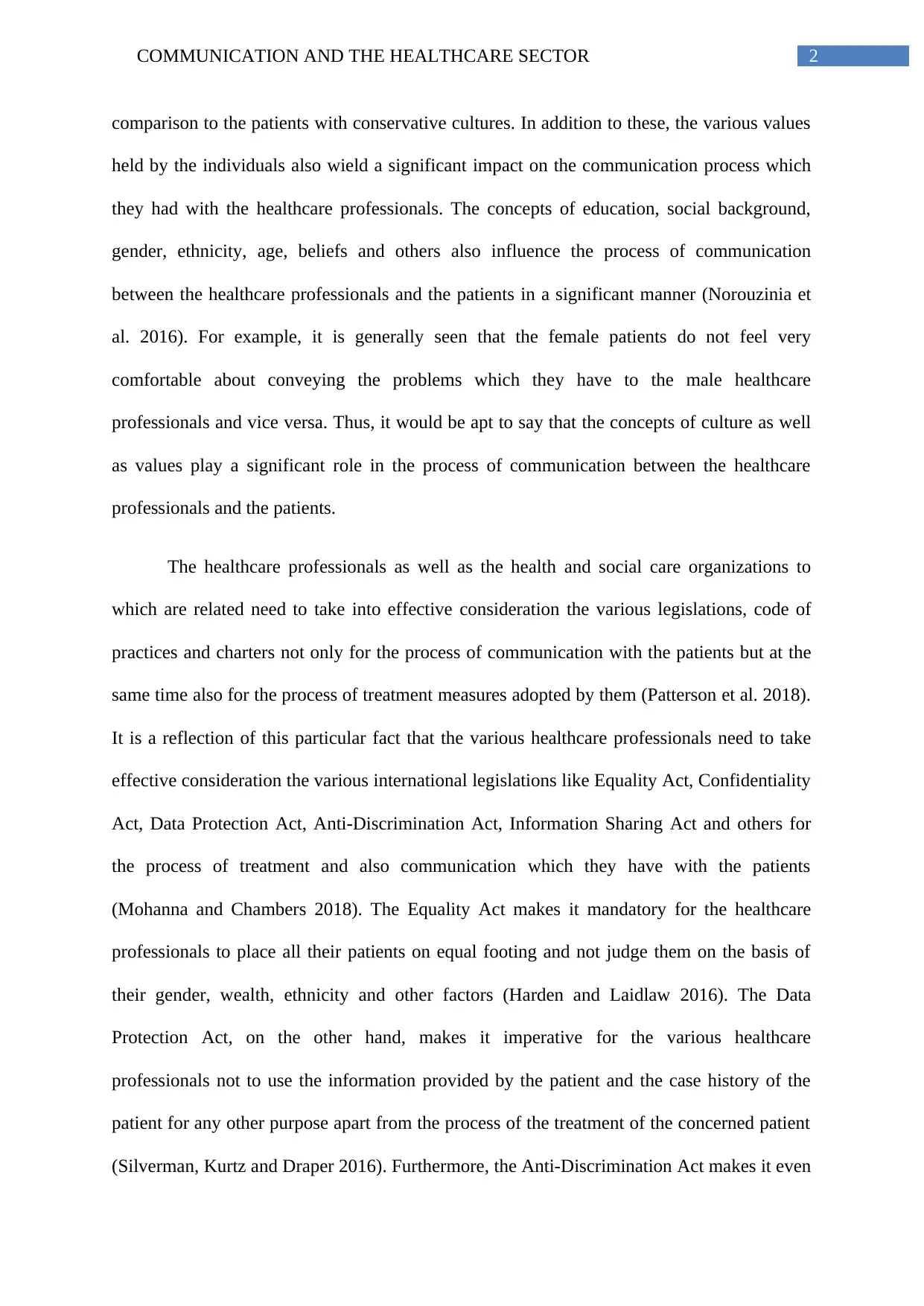
2COMMUNICATION AND THE HEALTHCARE SECTOR
comparison to the patients with conservative cultures. In addition to these, the various values
held by the individuals also wield a significant impact on the communication process which
they had with the healthcare professionals. The concepts of education, social background,
gender, ethnicity, age, beliefs and others also influence the process of communication
between the healthcare professionals and the patients in a significant manner (Norouzinia et
al. 2016). For example, it is generally seen that the female patients do not feel very
comfortable about conveying the problems which they have to the male healthcare
professionals and vice versa. Thus, it would be apt to say that the concepts of culture as well
as values play a significant role in the process of communication between the healthcare
professionals and the patients.
The healthcare professionals as well as the health and social care organizations to
which are related need to take into effective consideration the various legislations, code of
practices and charters not only for the process of communication with the patients but at the
same time also for the process of treatment measures adopted by them (Patterson et al. 2018).
It is a reflection of this particular fact that the various healthcare professionals need to take
effective consideration the various international legislations like Equality Act, Confidentiality
Act, Data Protection Act, Anti-Discrimination Act, Information Sharing Act and others for
the process of treatment and also communication which they have with the patients
(Mohanna and Chambers 2018). The Equality Act makes it mandatory for the healthcare
professionals to place all their patients on equal footing and not judge them on the basis of
their gender, wealth, ethnicity and other factors (Harden and Laidlaw 2016). The Data
Protection Act, on the other hand, makes it imperative for the various healthcare
professionals not to use the information provided by the patient and the case history of the
patient for any other purpose apart from the process of the treatment of the concerned patient
(Silverman, Kurtz and Draper 2016). Furthermore, the Anti-Discrimination Act makes it even
comparison to the patients with conservative cultures. In addition to these, the various values
held by the individuals also wield a significant impact on the communication process which
they had with the healthcare professionals. The concepts of education, social background,
gender, ethnicity, age, beliefs and others also influence the process of communication
between the healthcare professionals and the patients in a significant manner (Norouzinia et
al. 2016). For example, it is generally seen that the female patients do not feel very
comfortable about conveying the problems which they have to the male healthcare
professionals and vice versa. Thus, it would be apt to say that the concepts of culture as well
as values play a significant role in the process of communication between the healthcare
professionals and the patients.
The healthcare professionals as well as the health and social care organizations to
which are related need to take into effective consideration the various legislations, code of
practices and charters not only for the process of communication with the patients but at the
same time also for the process of treatment measures adopted by them (Patterson et al. 2018).
It is a reflection of this particular fact that the various healthcare professionals need to take
effective consideration the various international legislations like Equality Act, Confidentiality
Act, Data Protection Act, Anti-Discrimination Act, Information Sharing Act and others for
the process of treatment and also communication which they have with the patients
(Mohanna and Chambers 2018). The Equality Act makes it mandatory for the healthcare
professionals to place all their patients on equal footing and not judge them on the basis of
their gender, wealth, ethnicity and other factors (Harden and Laidlaw 2016). The Data
Protection Act, on the other hand, makes it imperative for the various healthcare
professionals not to use the information provided by the patient and the case history of the
patient for any other purpose apart from the process of the treatment of the concerned patient
(Silverman, Kurtz and Draper 2016). Furthermore, the Anti-Discrimination Act makes it even
⊘ This is a preview!⊘
Do you want full access?
Subscribe today to unlock all pages.

Trusted by 1+ million students worldwide
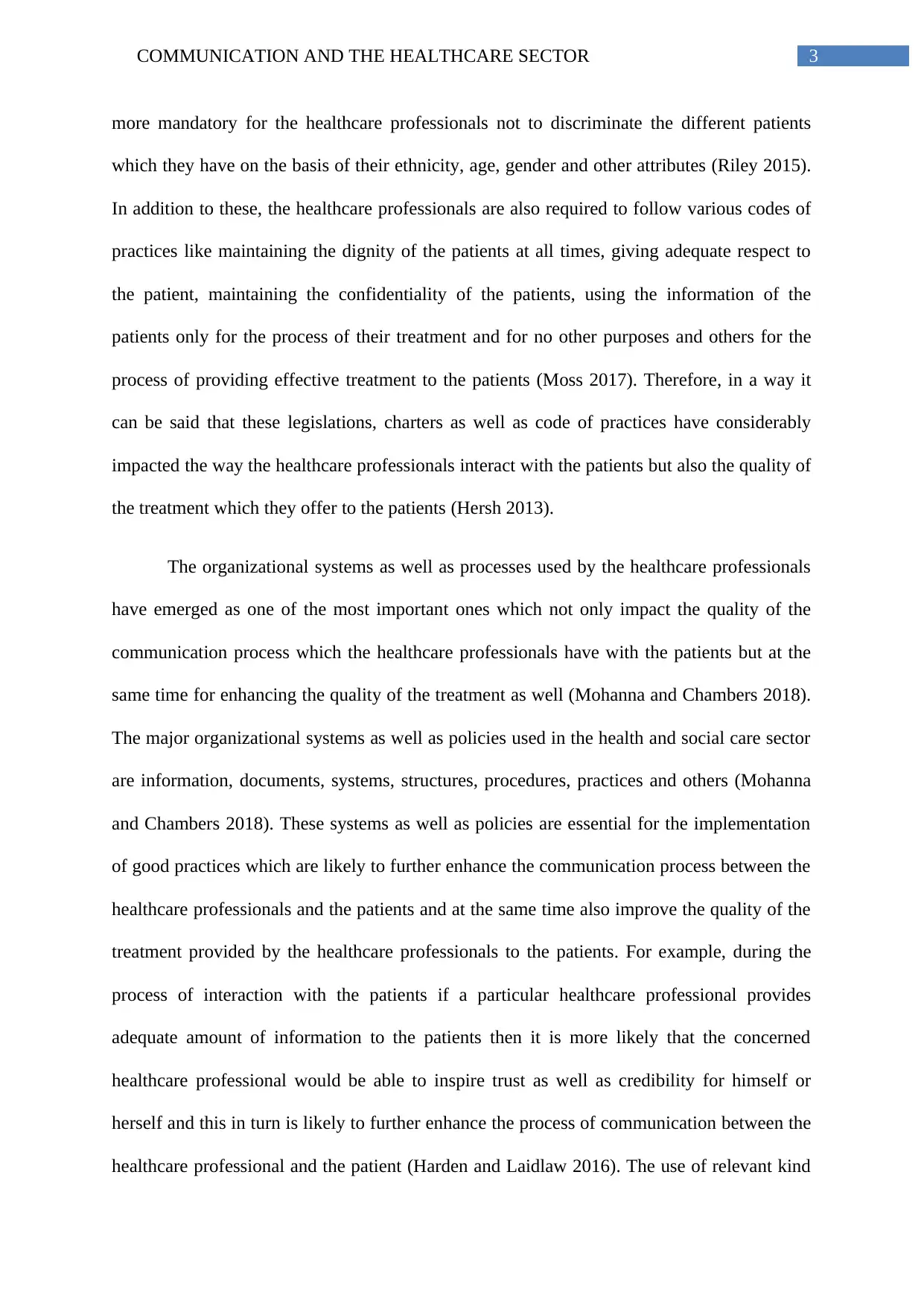
3COMMUNICATION AND THE HEALTHCARE SECTOR
more mandatory for the healthcare professionals not to discriminate the different patients
which they have on the basis of their ethnicity, age, gender and other attributes (Riley 2015).
In addition to these, the healthcare professionals are also required to follow various codes of
practices like maintaining the dignity of the patients at all times, giving adequate respect to
the patient, maintaining the confidentiality of the patients, using the information of the
patients only for the process of their treatment and for no other purposes and others for the
process of providing effective treatment to the patients (Moss 2017). Therefore, in a way it
can be said that these legislations, charters as well as code of practices have considerably
impacted the way the healthcare professionals interact with the patients but also the quality of
the treatment which they offer to the patients (Hersh 2013).
The organizational systems as well as processes used by the healthcare professionals
have emerged as one of the most important ones which not only impact the quality of the
communication process which the healthcare professionals have with the patients but at the
same time for enhancing the quality of the treatment as well (Mohanna and Chambers 2018).
The major organizational systems as well as policies used in the health and social care sector
are information, documents, systems, structures, procedures, practices and others (Mohanna
and Chambers 2018). These systems as well as policies are essential for the implementation
of good practices which are likely to further enhance the communication process between the
healthcare professionals and the patients and at the same time also improve the quality of the
treatment provided by the healthcare professionals to the patients. For example, during the
process of interaction with the patients if a particular healthcare professional provides
adequate amount of information to the patients then it is more likely that the concerned
healthcare professional would be able to inspire trust as well as credibility for himself or
herself and this in turn is likely to further enhance the process of communication between the
healthcare professional and the patient (Harden and Laidlaw 2016). The use of relevant kind
more mandatory for the healthcare professionals not to discriminate the different patients
which they have on the basis of their ethnicity, age, gender and other attributes (Riley 2015).
In addition to these, the healthcare professionals are also required to follow various codes of
practices like maintaining the dignity of the patients at all times, giving adequate respect to
the patient, maintaining the confidentiality of the patients, using the information of the
patients only for the process of their treatment and for no other purposes and others for the
process of providing effective treatment to the patients (Moss 2017). Therefore, in a way it
can be said that these legislations, charters as well as code of practices have considerably
impacted the way the healthcare professionals interact with the patients but also the quality of
the treatment which they offer to the patients (Hersh 2013).
The organizational systems as well as processes used by the healthcare professionals
have emerged as one of the most important ones which not only impact the quality of the
communication process which the healthcare professionals have with the patients but at the
same time for enhancing the quality of the treatment as well (Mohanna and Chambers 2018).
The major organizational systems as well as policies used in the health and social care sector
are information, documents, systems, structures, procedures, practices and others (Mohanna
and Chambers 2018). These systems as well as policies are essential for the implementation
of good practices which are likely to further enhance the communication process between the
healthcare professionals and the patients and at the same time also improve the quality of the
treatment provided by the healthcare professionals to the patients. For example, during the
process of interaction with the patients if a particular healthcare professional provides
adequate amount of information to the patients then it is more likely that the concerned
healthcare professional would be able to inspire trust as well as credibility for himself or
herself and this in turn is likely to further enhance the process of communication between the
healthcare professional and the patient (Harden and Laidlaw 2016). The use of relevant kind
Paraphrase This Document
Need a fresh take? Get an instant paraphrase of this document with our AI Paraphraser
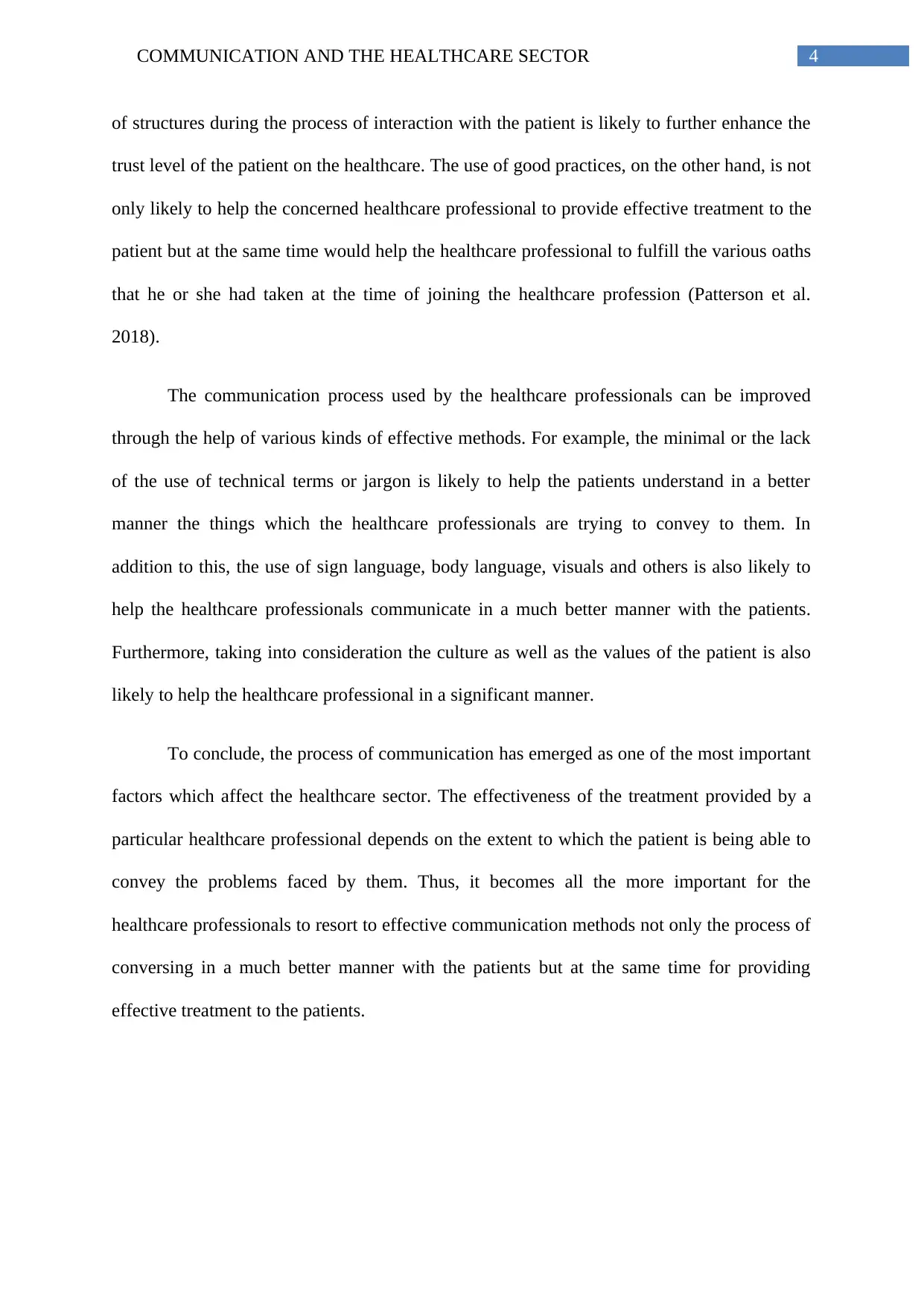
4COMMUNICATION AND THE HEALTHCARE SECTOR
of structures during the process of interaction with the patient is likely to further enhance the
trust level of the patient on the healthcare. The use of good practices, on the other hand, is not
only likely to help the concerned healthcare professional to provide effective treatment to the
patient but at the same time would help the healthcare professional to fulfill the various oaths
that he or she had taken at the time of joining the healthcare profession (Patterson et al.
2018).
The communication process used by the healthcare professionals can be improved
through the help of various kinds of effective methods. For example, the minimal or the lack
of the use of technical terms or jargon is likely to help the patients understand in a better
manner the things which the healthcare professionals are trying to convey to them. In
addition to this, the use of sign language, body language, visuals and others is also likely to
help the healthcare professionals communicate in a much better manner with the patients.
Furthermore, taking into consideration the culture as well as the values of the patient is also
likely to help the healthcare professional in a significant manner.
To conclude, the process of communication has emerged as one of the most important
factors which affect the healthcare sector. The effectiveness of the treatment provided by a
particular healthcare professional depends on the extent to which the patient is being able to
convey the problems faced by them. Thus, it becomes all the more important for the
healthcare professionals to resort to effective communication methods not only the process of
conversing in a much better manner with the patients but at the same time for providing
effective treatment to the patients.
of structures during the process of interaction with the patient is likely to further enhance the
trust level of the patient on the healthcare. The use of good practices, on the other hand, is not
only likely to help the concerned healthcare professional to provide effective treatment to the
patient but at the same time would help the healthcare professional to fulfill the various oaths
that he or she had taken at the time of joining the healthcare profession (Patterson et al.
2018).
The communication process used by the healthcare professionals can be improved
through the help of various kinds of effective methods. For example, the minimal or the lack
of the use of technical terms or jargon is likely to help the patients understand in a better
manner the things which the healthcare professionals are trying to convey to them. In
addition to this, the use of sign language, body language, visuals and others is also likely to
help the healthcare professionals communicate in a much better manner with the patients.
Furthermore, taking into consideration the culture as well as the values of the patient is also
likely to help the healthcare professional in a significant manner.
To conclude, the process of communication has emerged as one of the most important
factors which affect the healthcare sector. The effectiveness of the treatment provided by a
particular healthcare professional depends on the extent to which the patient is being able to
convey the problems faced by them. Thus, it becomes all the more important for the
healthcare professionals to resort to effective communication methods not only the process of
conversing in a much better manner with the patients but at the same time for providing
effective treatment to the patients.
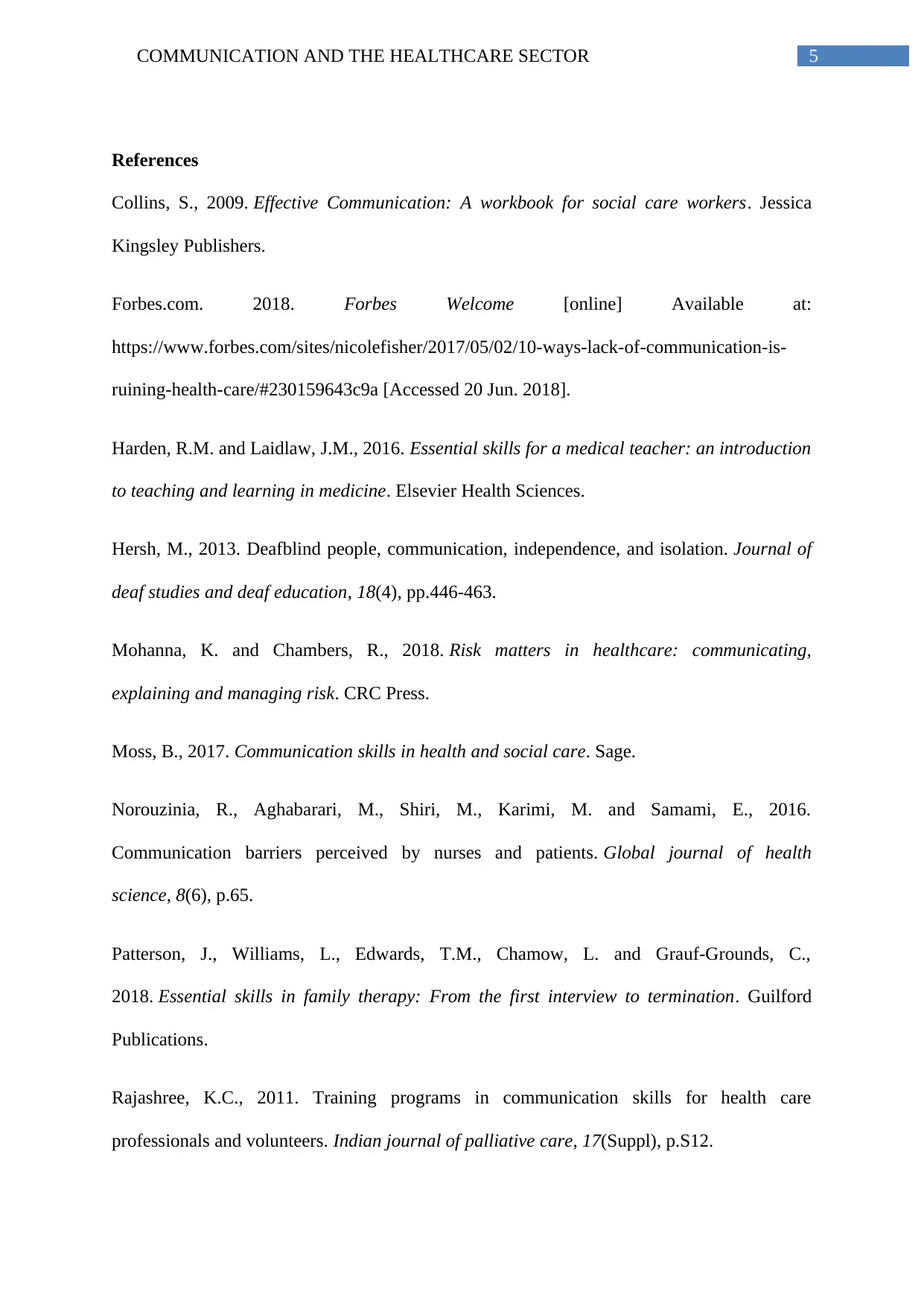
5COMMUNICATION AND THE HEALTHCARE SECTOR
References
Collins, S., 2009. Effective Communication: A workbook for social care workers. Jessica
Kingsley Publishers.
Forbes.com. 2018. Forbes Welcome [online] Available at:
https://www.forbes.com/sites/nicolefisher/2017/05/02/10-ways-lack-of-communication-is-
ruining-health-care/#230159643c9a [Accessed 20 Jun. 2018].
Harden, R.M. and Laidlaw, J.M., 2016. Essential skills for a medical teacher: an introduction
to teaching and learning in medicine. Elsevier Health Sciences.
Hersh, M., 2013. Deafblind people, communication, independence, and isolation. Journal of
deaf studies and deaf education, 18(4), pp.446-463.
Mohanna, K. and Chambers, R., 2018. Risk matters in healthcare: communicating,
explaining and managing risk. CRC Press.
Moss, B., 2017. Communication skills in health and social care. Sage.
Norouzinia, R., Aghabarari, M., Shiri, M., Karimi, M. and Samami, E., 2016.
Communication barriers perceived by nurses and patients. Global journal of health
science, 8(6), p.65.
Patterson, J., Williams, L., Edwards, T.M., Chamow, L. and Grauf-Grounds, C.,
2018. Essential skills in family therapy: From the first interview to termination. Guilford
Publications.
Rajashree, K.C., 2011. Training programs in communication skills for health care
professionals and volunteers. Indian journal of palliative care, 17(Suppl), p.S12.
References
Collins, S., 2009. Effective Communication: A workbook for social care workers. Jessica
Kingsley Publishers.
Forbes.com. 2018. Forbes Welcome [online] Available at:
https://www.forbes.com/sites/nicolefisher/2017/05/02/10-ways-lack-of-communication-is-
ruining-health-care/#230159643c9a [Accessed 20 Jun. 2018].
Harden, R.M. and Laidlaw, J.M., 2016. Essential skills for a medical teacher: an introduction
to teaching and learning in medicine. Elsevier Health Sciences.
Hersh, M., 2013. Deafblind people, communication, independence, and isolation. Journal of
deaf studies and deaf education, 18(4), pp.446-463.
Mohanna, K. and Chambers, R., 2018. Risk matters in healthcare: communicating,
explaining and managing risk. CRC Press.
Moss, B., 2017. Communication skills in health and social care. Sage.
Norouzinia, R., Aghabarari, M., Shiri, M., Karimi, M. and Samami, E., 2016.
Communication barriers perceived by nurses and patients. Global journal of health
science, 8(6), p.65.
Patterson, J., Williams, L., Edwards, T.M., Chamow, L. and Grauf-Grounds, C.,
2018. Essential skills in family therapy: From the first interview to termination. Guilford
Publications.
Rajashree, K.C., 2011. Training programs in communication skills for health care
professionals and volunteers. Indian journal of palliative care, 17(Suppl), p.S12.
⊘ This is a preview!⊘
Do you want full access?
Subscribe today to unlock all pages.

Trusted by 1+ million students worldwide
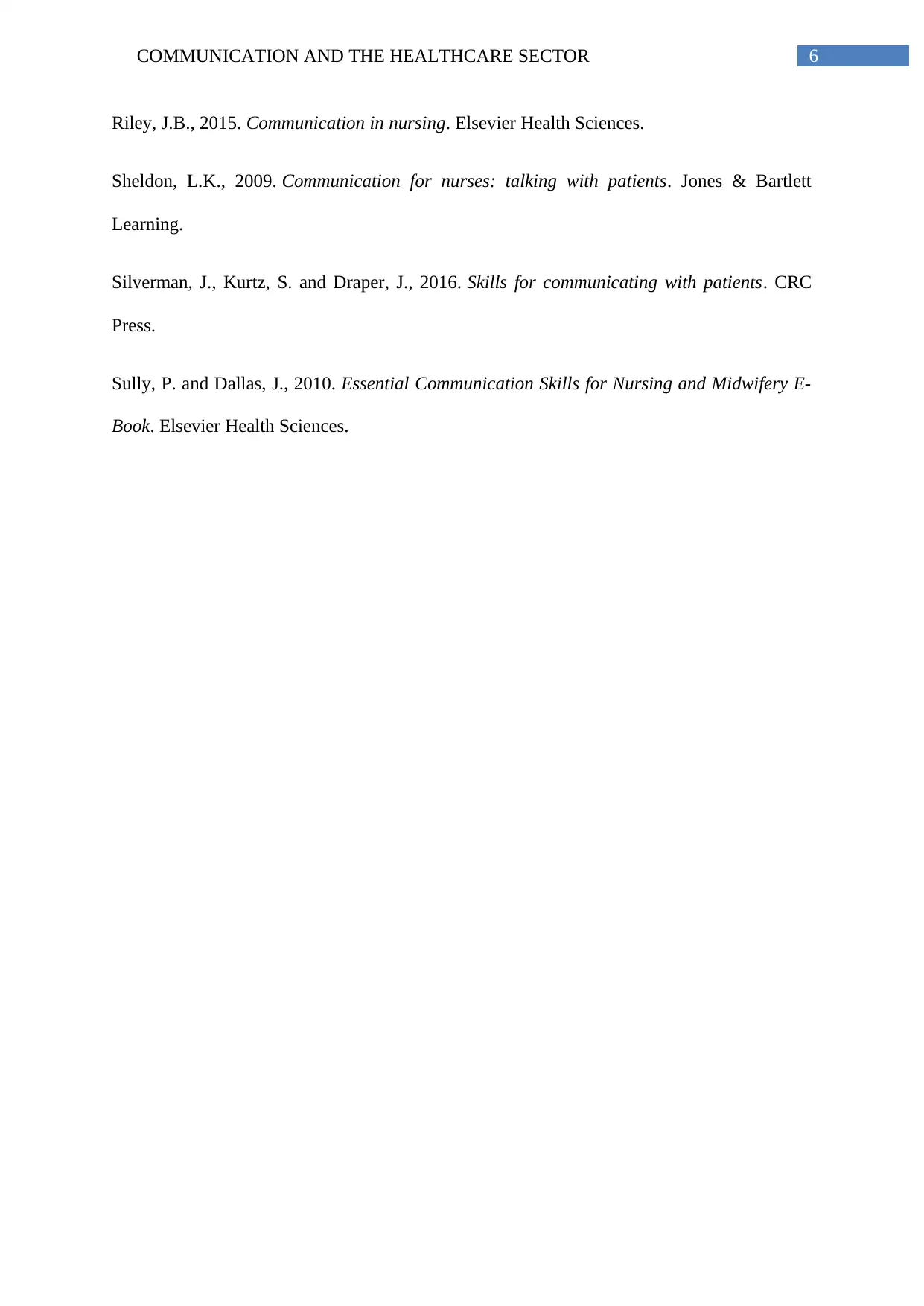
6COMMUNICATION AND THE HEALTHCARE SECTOR
Riley, J.B., 2015. Communication in nursing. Elsevier Health Sciences.
Sheldon, L.K., 2009. Communication for nurses: talking with patients. Jones & Bartlett
Learning.
Silverman, J., Kurtz, S. and Draper, J., 2016. Skills for communicating with patients. CRC
Press.
Sully, P. and Dallas, J., 2010. Essential Communication Skills for Nursing and Midwifery E-
Book. Elsevier Health Sciences.
Riley, J.B., 2015. Communication in nursing. Elsevier Health Sciences.
Sheldon, L.K., 2009. Communication for nurses: talking with patients. Jones & Bartlett
Learning.
Silverman, J., Kurtz, S. and Draper, J., 2016. Skills for communicating with patients. CRC
Press.
Sully, P. and Dallas, J., 2010. Essential Communication Skills for Nursing and Midwifery E-
Book. Elsevier Health Sciences.
1 out of 7
Related Documents
Your All-in-One AI-Powered Toolkit for Academic Success.
+13062052269
info@desklib.com
Available 24*7 on WhatsApp / Email
![[object Object]](/_next/static/media/star-bottom.7253800d.svg)
Unlock your academic potential
Copyright © 2020–2025 A2Z Services. All Rights Reserved. Developed and managed by ZUCOL.





